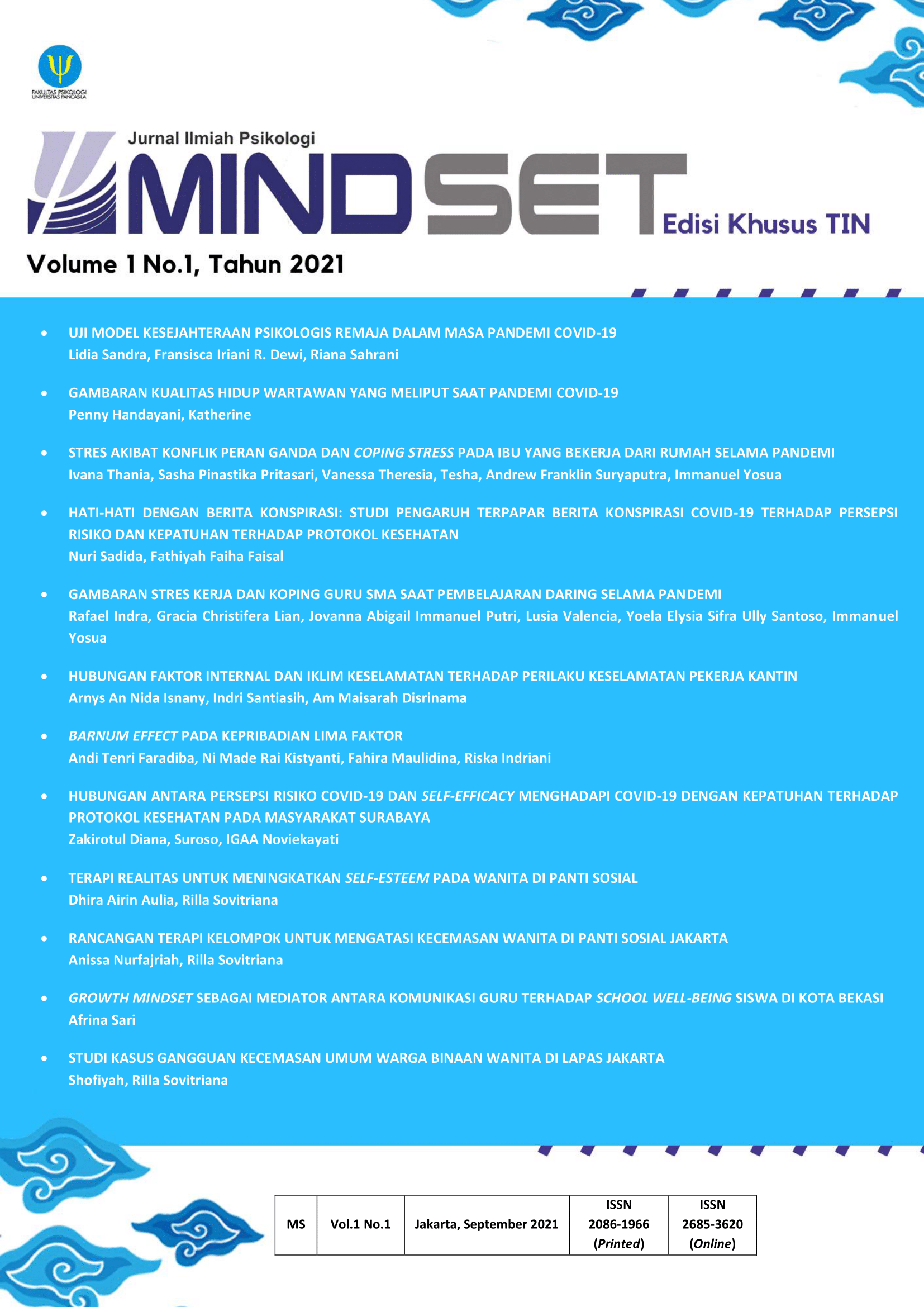Studi Kasus Gangguan Kecemasan Umum Warga Binaan Wanita di Lapas Jakarta
Abstract views: 3333 | PDF (Bahasa Indonesia) downloads: 4504
Abstract
Individuals who experience anxiety and worry when they are prisoners is normal, but if there is cognitive distortion and has been disturbing that eventually arises with physical complaints, it needs to be addressed. The subject of this study was a 39-year-old woman whose met the diagnostic criteria in the DSM-IV TR generalized anxiety disorder and is currently serving a prison term. Overcoming cases of generalized anxiety disorder, the subject was assisted by Rational Emotive Behavior Therapy (REBT) which was carried out for 10 sessions. This study uses a qualitative approach with case study methods, data analysis techniques using pattern matching and analysis of development results. The results of the measurement of anxiety using the Hamilton Anxiety Rating Scale (HARS) in the form of pre-test and post-test. The results of the pre-test showed in the category of moderate anxiety, based on the results of the application of Rational Emotive Behavior Therapy on the subject showing calmer, more peaceful behavior, more stable emotions, able to concentrate, able to sleep, and able to think rationally, these result are supported by the post test results which show a decrease in anxiety to a mild category
References
American Psychiatric Assosiation. (2013), Diagnostic and Statistical Manual of Mental Disorder (Fourth Ed.), Washington DC: American Psychiatric Assosiation.
Beck, A. T. (1976). Cognitive Therapy and the Emotional Disorder. New York: International University Press.
Beck, A. T., Emery, G., & Greenberg, R. L. (1985). Anxiety Disorders and Phobias: A Cognitive Perspective. New York: The Guilford Press.
Bingswanger, I. A., Merrill, J. O., Patrick, M. K., White, M. C., Booth, R. E., & Elmore, J. G. (2010). Gender differences in chronic medical, psychiatricc, and substance-dependence disorder among jail inmates. American Journal of Public Health, 100(3), 476-482. doi: 10.2105/AJPH.2008.149591
Bradizza, C. M., Stasiewicz, P. R., & Paas, N. D. (2006). Relapse to alcohol and drug use among individuals diagnosed with co-occurring mental health and substance use disorders. Clinical Psychology Review, 26, 162-178.
Butler, T., Allnut, S., Cain, D., Owens, D., & Muller, C. (2005). Mental disorder in the New South Wales prisoner population. Australian and New Zealand Journal of Psychiatry, 39(5), 407-413.
Cormier, W. H., & Cormier, L. S. (1985). Interviewing Strategy for Helper Foundamental Skill and Cognitif Intervutions, Second Edition Books/Cole. Callifornia: Montary.
Corey, G. (2009). Teori dan Praktek Konseling dan Psikoterapi. Bandung: PT. Eresco.
Davison. G. C, Neale J. M., & Kring, A. M. (2004). Psikologi Abnormal edisi ke-9. Rajawali Pers. Jakarta.
Drake, D. H., Darke, S., & Earle, R. (2015). Prison Life, Sociology of: Recent Perspectives from the United Kingdom. International Encyclopedia of the Social & Behavioral Sciences: Second Edition (Second Edi, Vol. 18). Elsevier. https://doi.org/10.1016/B978-0-08-097086-8.45035-X
Fakultas Psikologi. (1987). Proyeksi kepribadian dalam gambar figure manusia. Universitas Padjajaran. Bandung.
Fakultas Psikologi. (1996). Laporan interpretasi tes grafis. Universitas Persada Indonesia Y.A.I. Jakarta.
Friedman, F., S., Thase, M., F., & Wright, J., Tasman, I., A., Jerald, K., Je_rey, A., Liberman, Michael, B., & Maj, M. (2008). Cognitive Behavioral Therapy for Social Anxiety Disorder. New York; Routledge Taylor & Francis Group.
Hawari, D. (2001). Manajemen Stress, Cemas & Depresi. Jakarta : Psikiatri FKUI.
Dwijayanti, Y., & Herdiana, I. (2011). Perilaku Seksual Anak Jalanan Ditinjau dengan Teori Health Belief Model (HBM). Jurnal INSAN, 13(2).
Ikatan Psikologi Klinis Himpunan Psikologi Indonesia. (2008). SPPK: Standar pelayanan psikologi klinis. Jakarta.
Taylor, J. A. (2015). Skala kepribadian manifestasi kecemasan. J. Abnormal dan Social Psych., 48(2), 285-290.
Knapp, P., & Beck, A. T. (2008). Cognitive therapy: foundation, conceptual models, applications and research. Journal of Psychiatry. Latipun. (2005). Psikologi Konseling. Malang: UMM Press.
Martin, G. & Pear, J. (2015). Modifikasi perilaku: Makna dan Penerapannya. Yogyakarta: Pustaka Pelajar.
Nursalim, M. (2005). Strategi Konseling Meningkatkan Kemampuan Penyesuaian Diri 9 Surabaya: Unesa University Press.
Oemarjoedi, A. K. (2003). Pendekatan Cognitive Behavior Dalam Psikoterapi. Jakarta: Kreatif media.
Rapgay, L., Bystritsky, A., Dafter, R. E., & Spearman, M. (2011). New Strategies for Combining Mindfulness with Integrative Cognitive Behavioral Therapy for the Treatment of Generalized Anxiety Disorder. J Rat-Emo Cognitive-Behav Ther, 29, 92-119.
Savitri, R. (2003). Kecemasan Bagaimana Mengatasi Penyebabnya. Jakarta: Pustaka Populer Obor.
Woodfield, R., Boduszek, D., & Willmott, D. (2019). Introduction and psychometric validation of the prison personnel trauma measure (PPTM). European Journal of Trauma & Dissociation, 3(4), 257–262. https://doi.org/10.1016/j.ejtd.2018.04.005









